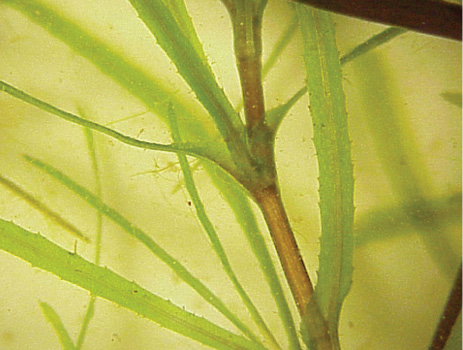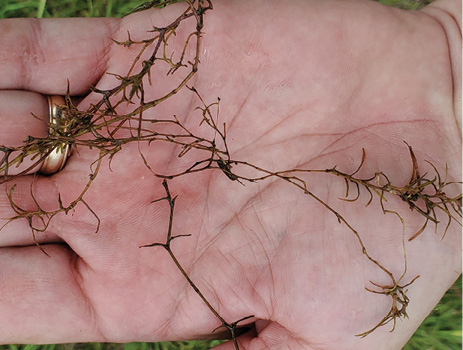Southern Naiad | Najas guadalupensis
Submersed | Native



Southern naiad is a submersed plant that is a common Mississippi pond problem. It has long stems with many branches.
Leaves are narrow (one-sixteenth of an inch) and about an inch long. They are arranged oppositely on the stem. The leaf margins have tiny teeth that require magnification to see. They may sometimes be arranged in whorls of three, but two opposite leaves are more common. The leaf color is usually green to slightly purple.
Southern naiad is a flowering plant, but the flowers are very small and easily overlooked. Seeds are elliptical in shape and inconspicuous.
This species may be confused with sago pondweed (Stuckenia pectinata), bushy/leafy pondweed (Potamogeton foliosus) or widgeon grass (Ruppia maritima). Sago pondweed, however, has alternate leaves, and both similar species have leaves that are several inches or more in length.
Management Value
Southern naiad is a native species and a primary food source for waterfowl. The plant provides habitat for invertebrates, which feed fish, reptiles and amphibians, and bird species. Small and large fish use the dense growth as cover.
However, this species grows rapidly and can quickly become a problem in small waters. It interferes with human activities, prevents predator-prey interactions, and can reduce oxygen levels at night or during die-offs. It is not a recommended plant to establish in small ponds and should be controlled at first sign of becoming a problem.
Recommended Controls
Option 1: Triploid Grass Carp. Stock 5 to 10 grass carp per acre to reduce moderate pondweed infestations; stock 15 or more per acre for severe infestations. Note that abundant grass carp can impact other fish and can survive 20 years.
Stock 8- to 10-inch triploid grass carp in ponds that have established largemouth bass populations.
Option 2: Diquat (3.73-pound formulation). Diquat (0.25 gallon per acre-foot of water) should be applied as a submersed injection (application using a wand or hose). Determine pond volume prior to application. Do not exceed annual herbicide rate limits as stated on the product label.
Option 3: Chelated Copper (0.8-pound formulation). Chelated copper should be applied as a submersed injection (3.3 gallons per acre-foot of water). Determine pond volume prior to application. Copper can be toxic to fish when water alkalinity is low. Do not use copper in catfish or koi ponds when alkalinity is less than 50 ppm. Do not exceed annual herbicide rate limits as stated on the product label.
Option 4: Penoxsulam (2.0-pound formulation). Penoxsulam should be applied as a submersed injection (1.75 ounces per acre-foot of water). Determine pond volume prior to application. Do not exceed annual herbicide rate limits as stated on the product label.
NOTE: Acre-foot = average depth of pond multiplied by pond acreage; average depth is calculated by taking the depth at 20 points across a water body and averaging the values.
Treat ponds when the plants are actively growing and the water temperature is at least 60˚F. It is best to treat one-third of the pond at a time for larger water bodies, with 2 weeks or more separating applications. After the entire pond has been treated, a repeat whole-pond application may be necessary to eliminate remaining plants.
Read and follow all chemical label instructions, especially the section on the use of personal protection equipment.
Photo Credits Middle: Timothy W. Wilson, UF-IFAS Bradford County Extension

The information given here is for educational purposes only. References to commercial products, trade names, or suppliers are made with the understanding that no endorsement is implied and that no discrimination against other products or suppliers is intended.
Publication 3735-12 (POD-11-23)
By Wes Neal, PhD, Extension/Research Professor, Wildlife, Fisheries, and Aquaculture; Dennis Riecke, Fisheries Coordinator, Mississippi Department of Wildlife, Fisheries, and Parks; and Gray Turnage, PhD, Assistant Research/Extension Professor, GeoSystems Research Institute.
The Mississippi State University Extension Service is working to ensure all web content is accessible to all users. If you need assistance accessing any of our content, please email the webteam or call 662-325-2262.



